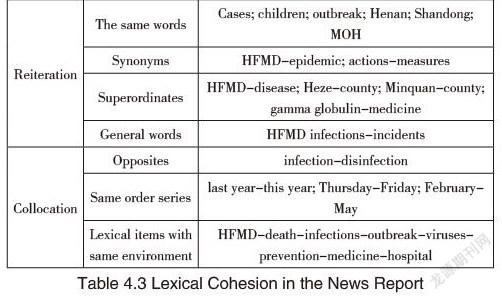A Case Study of Cohesive Devices in an English News Report
2019-09-10陈明
陈明



Abstract: Based on Halliday and Hasans classification, this study investigates CDs in an English news report concerning HFMD. It is found that (1) no substitution was found in the text. The lack of substitution might result from formality of news. (2) A wide range of temporal conjunctions occurred in the report. This common occurrence might be due to the timeliness nature of news. (3) Compared with other categories, lexical cohesion had a wider distribution and established longer cohesive ties to establish text coherence.
Keywords: CDs; coherence; English news report
1. Introduction
In systemic-functional linguistics, text refers to any stretch of language felt to be unified. To name a sequence of sentences text is to indicate that these sentences are interrelated, but not randomly scattered in a group (Yang 2011). An inherent property of text is coherence, the feeling that sentences are mutually dependent. There are several ways to realize coherence, one of which is cohesive devices (CDs). CDs are linguistic features used to connect sentences together. The study of CDs is significant, as it cannot only enlighten learners on the role of CDs in realizing coherence but inspire them about appropriate use of CDs in English texts.
This study intends to analyze CDs in an English news report concerning hand-foot-mouth disease (HFMD). It first enumerates CDs in the text and then it provides examples to illustrate how CDs function to realize text coherence. Specifically, two research questions are addressed:
(1) What types of CDs are used in the news report?
(2) How do these CDs realize coherence in the news report?
2. Classification of CDs
This study divides CDs into three categories, namely grammatical cohesion, lexical cohesion and conjunction. Specifically, grammatical cohesion encompasses reference, substitution and ellipsis. Reference is the items that “refer to something else for their semantic interpretation” (Yang 2011: 136). Substitution is the replacement of one lexical item by another. It is nominal, verbal and causal based on word class of the replaced items. Ellipsis is “something left unsaid” (Yang 2011: 136). Similar to substitution, it is characterized as nominal, verbal and clausal.
Lexical cohesion is the semantic relations between related lexical items across clause and sentence boundaries. The semantic relations have two types, reiteration and collocation (Halliday & Hasan 1976). Reiteration is meaning repetition, realized by the same word, synonyms, hyponyms and general words. Collocation is the association between lexical items that co-occur. It is realized by opposites, the same order series, part-and-whole, and members from the same lexical environment (Yang 2011).
Conjunction is treated grammatically in Halliday and Hasans classification (1976). However, considering that it cannot only hang sentences together but denote semantic meanings, this study takes conjunction as a separate category on the continuum between two extremes. It covers four subcategories, namely addition, adversative, causal, and temporal relation.
3. Research Methodology
3.1 Material
The material was an English news report concerning HMFD, released by China Daily. Since China Daily was the authorized English portal, its news could represent ordinary use of English.
3.2 Research Method
Qualitative method is adopted in this study. Specifically, CDs were first collected based on Halliday and Hasans classification. Then representative examples were selected to analyze the function of devices in context.
4. Analysis of CDs in the English News Report
4.1 Analysis of Grammatical Cohesion
Table 4.1 presents the grammatical cohesions in the news report. It is interesting to note that no substitution occurs in the text. Considering that substitution characterizes spoken register, it is reasonable that the reporter eschews this device in the formal news report.
Example 1 As of Thursday, Henan had reported 4,761 HFMD cases, among which 419 (cases) were from Minquan. Of the 18 fatalities, seven (fatalities) were reported in Henan and five (were reported) in Shangdong.
Example 1 comprises three ellipses, one nominal and two verbal. These ellipses are used for two reasons. First, since HFMD cases appears in the preceding sentence, it is verbose to re-mention it. Therefore, similar expressions like HFMD cases and fatalities are omitted. Second, it might be used out of the need for coherence. McCarthy (1991: 43) defines ellipsis as “the omission of elements normally required by the grammar which the writer assumes are obvious from the context and therefore need not be raised”. Defined as such, ellipses are what remind readers of something unsaid. In order to work out the omitted information, readers need move beyond the single sentence and search the context. The moment readers succeed to look for the corresponding information, the semantic relation between two sentences is built.
4.2 Analysis of Conjunction
Table 4.2 demonstrates the conjunctions in the report. As can be observed, and was repeatedly used in the text, which might be explained by the limited number of conjunction. In addition, temporal expressions outnumber other categories. This might be ascribed to the nature of news reports. News reports, as the major means to inform people what is happening in the world, should transmit the latest news to the public. Consequently, the reporters need employ numerous temporal expressions relating the present to show the current situation of HFMD.
Example 2 At present, around 2,000 to 3,000 new HFMD cases are being reported daily. From now on, the daily reported cases will keep increasing.
Example 2 contains respective temporal conjunctions, at present and from now on. The two devices are used for two reasons. First, it indicates that the event is related to now, thus conforming to the timeliness nature of new reporting. Second, it satisfies the need of text coherence. The first conjunction, at present, concerns events happening at the moment, while the second, from now on, takes the present as the departing point and predicts the future. Thus, the combination of two conjunctions presents a logical relation in terms of time order. Considering that the number of cases in the future can only be predicted based on the current statistics, the two sentences are organized in a sequence so that logical relationship is established and coherence is constructed.
4.3 Analysis of Lexical Cohesion
Table 4.3.1 shows the distribution of reiteration in the report. According to the table, the most common expression is “HMFD/epidemic/the disease/incidents” which appears eight times, followed by “cases” seven times, “children” four, “outbreak”, “Henan” and “Shangdong” three respectively. Interestingly, these highly frequent lexical items can be strung together in a sentence to denote the main idea of the report. That is, the HFMD breaks out in Henan and Shangdong and children become the victim to the disease. With regard to collocation, a long and complex cohesive tie concerning disease is established in the text. With the cohesive tie, the notion, disease, has a wide distribution, ranging from the first sentence to the end of the text. This distribution might result from the main idea of the news. That is, the reporter replicates the central notion to stick to the theme.
Example 3 As of Thursday, Henan had reported 4,761 HFMD cases, among which 419 were from Minquan…and a national teleconference was held last Friday to deal with the recent outbreak.
Example 3 involves two temporal expressions, Thursday and last Friday, both of which share the same order series. The first sentence introduces the number of HFMD cases reported on Thursday, while the second presents the government reaction to the outbreak. It is obvious that the two events take place in a time sequence. The co-occurrence of time adverbials enables readers to understand the sequential relationship between two sentences and thus binds the two sentences together.
5. Conclusion
This study qualitatively analyzed CDs in the English news report. It is found that (1) no substitution occurred in the text, which might be due to the formality of news. Grammatical cohesions served as overt devices and formed cohesive ties to guide readers to construct text coherence. (2) Due to the timeliness nature of news, temporal conjunctions outnumber other types. Conjunction prompted readers to coherently perceive the text by operating as overt signals to mark semantic relationships between sentences. (3) Lexical cohesion was rich in number and complicated in realization form. It had a wide distribution in the text and established long cohesive ties to establish coherence.
References
[1]Halliday, M. A. K. & R. Hasan. 1976. Cohesion in English [M]. London: Longman.
[2]McCarthy, M. 1991. Discourse Analysis for Language Teachers [M]. Cambridge: Cambridge University Press.
[3]楊忠. 2011. 英语语言学导论[M]. 北京:人民大学出版社.
